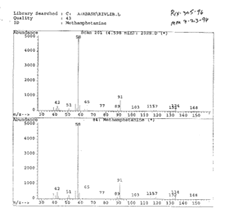Clandestine Methamphetamine Manufacture: Part III
SOURCES OF ERROR DUE TO CROSS CONTAMINATION IN ANALYSIS
OF SEIZED SAMPLES FOR CONTROLLED SUBSTANCES BY THE
CALIFORNIA DEPARTMENT OF JUSTICE CRIMINALISTICS LABORATORY
[ISBN 0-9621181-4-1]
$15.50 (US)
(23 Pages of Text + 15 Exhibits)
 Here is an actual criminal prosecution for methamphetamine manufacture based on the seizure of approximately 100 microliter (one tenth of one milliliter) of solution suspected of containing methamphetamine. The total volume (0.1 ml) of the suspect sample is significant because it determines the total amount of controlled substance which could potentially be present in solution. The argument is advanced that trace amounts of controlled substance (ie 0-50 mg) detected in a seized sample could result from intentional or inadvertent contamination in the Law Enforcement Chain of Custody during or subsequent to seizure of the sample or during analysis of the sample by the Criminalistics Laboratory. Here is an actual criminal prosecution for methamphetamine manufacture based on the seizure of approximately 100 microliter (one tenth of one milliliter) of solution suspected of containing methamphetamine. The total volume (0.1 ml) of the suspect sample is significant because it determines the total amount of controlled substance which could potentially be present in solution. The argument is advanced that trace amounts of controlled substance (ie 0-50 mg) detected in a seized sample could result from intentional or inadvertent contamination in the Law Enforcement Chain of Custody during or subsequent to seizure of the sample or during analysis of the sample by the Criminalistics Laboratory.
This e-Report examines several contamination scenarios, which can be used in defense of allegations of methamphetamine manufacture.
This e-Report also provides a detailed discussion of the reaction pathway and mechanistic considerations for the reductive synthesis of methamphetamine from ephedrine and hydriodic acid. To constitute a defense to methamphetamine manufacture it is argued that the absence of essential catalysts in the seized sample explain the analytical results which detect significant side reaction products of the manufacturing pathway. In addition, the presence of labile reaction intermediates as indicated by the DOJ Criminalistics Laboratory Results for the seized sample, suggest chemical reactions in progress during DOJ analysis which occurred approximately 8 weeks subsequent to the date of seizure of the sample. The e-Report elaborates many of the technical issues which may be relevant to a defense to allegations of methamphetamine manufacture.
CONTENTS
I. Defense Theory of the Case of Contamination/Cross Contamination of Sample 409S
A. Prosecutor’s Allegations
B. Total Volume Issue
C. Defense Theory of “Reaction in Progress” on the Date of DOJ Analysis: The Labile Inermediate Argument
D. Injection Port Reaction Theory
II. Reaction Pathway and Mechanistic Considerations
III. GCMS Analytical Results for Sample 409S
A. Gas-Liquid Chromatography
1. Description of the Method
2. Gas Chromatography Conditions: Sample 409S
3. Analytical Results-Capillary GC; Sample 409S
B. Mass Spectrometry
1. Description of the Method
a. Selective Ion Monitoring
2. Mass Spectra of Phenyl-2-Propanone
3. Selective Ion Monitoring for Ephedrine, Methamphetamine, Aziridines
C. Quantitation Using Internal Standards
1. Theoretical Considerations
2. Experimental Procedure
3. Quantitation of Methamphetamine in Sample 409S
4. Quantitation of Ephedrine in Sample 409S
$15.50 (US)
|
|